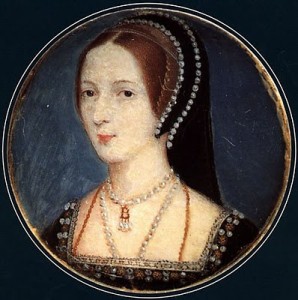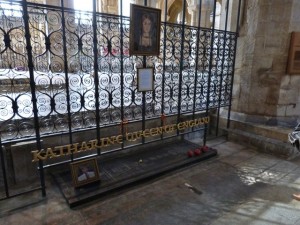 On 29th January 1536, Queen Anne Boleyn, second wife of Henry VIII, miscarried “a male child which she had not borne 3½ months”.1
On 29th January 1536, Queen Anne Boleyn, second wife of Henry VIII, miscarried “a male child which she had not borne 3½ months”.1
As well as being a huge blow for both Anne and the king, this miscarriage was to have devastating consequences for Anne, her brother, some of their friends and Anne’s daughter, Elizabeth. While the miscarriage alone did not bring about Anne Boleyn’s fall in May 1536, the safe delivery of a son would have kept Anne safe and protected her marriage and her status as queen. You can read more about my thoughts on this in my article Anne Boleyn “miscarried of her saviour”
It is often claimed that Anne Boleyn miscarried a deformed foetus, a monster, and that this was a factor in her downfall. However, this claim is not backed up by the contemporary sources – click here to read my article examining the primary source accounts of Anne’s miscarriage.
Anne Boleyn miscarried her baby on the day of Catherine of Aragon’s funeral at Peterborough Abbey, now Peterborough Cathedral. Catherine, who had been Henry VIII’s first wife, was buried as the Dowager Princess of Wales, as the widow of Arthur, Prince of Wales, due to the annulment of her marriage to Henry VIII.
On 21st January, Eustace Chapuys, the imperial ambassador, wrote of what he’d heard regarding arrangements for Catherine’s burial:
“Great preparations are being made for the burial of the good Queen, and according to a message received from Master Cromwell the funeral is to be conducted with such a pomp and magnificence that those present will scarcely believe their eyes. It is to take place on the 1st of February; the chief mourner to be the King’s own niece, that is to say, the daughter of the duke of Suffolk [Frances Brandon]; next to her will go the Duchess, her mother; then the wife of the duke of Norfolk [Elizabeth Stafford], and several other ladies in great numbers.”2
On 17th February, he wrote again with details of the funeral, which he did not attend:

Chapuys would be pleased to know that her grave is now marked “Katharine Queen of England” and that Peterborough Cathedral hold a “Katharine of Aragon Festival” every year to commemorate this Tudor queen. Here is the programme for this year’s festival:
- Thursday 28th January – 5.30pm, Sung Eucharist in commemoration of Katharine of Aragon, with music from the Tudor period, sung by Peterborough Cathedral Choir.
- Friday 29th January – 8.30am, Mass at Peterborough Cathedral.
- Friday 29th January – 10.15am, Civic dignitaries and schoolchildren proceed from Peterborough Museum to the Cathedral, accompanied by the period musicians of Hautbois. 10.30am, Service of Commemoration at Peterborough Cathedral, during which wreaths will be laid on Katherine’s tomb. The service is followed by a Tudor history day for schools, in the Cathedral.
- Friday 29th January – 2.00pm, Guided tour of Peterborough Cathedral.
- Friday 29th January – 6.00pm, A Tudor-style Pottage and Ale Supper in the Becket Chapel, within the Cathedral Precincts.
- Friday 29th January – 7.30pm, Festival Lecture: Dr Jonathan Foyle on “The Forgotten Origins of the Tudor Rose”.
- Saturday 30th January – 10.00am–5.00pm: At Home with the Tudors at Peterborough Museum.
- Saturday 30th January – 2pm Guided Tour of the Cathedral.
- Saturday 30th January – 5.30pm, Choral Evensong at Peterborough Cathedral.
- Sunday 31st January – 10.00am–5.00pm, At home with the Tudors at Peterborough Museum.
- Sunday 31st January – 2.00pm, Tudor Peterborough Walk starting at Peterborough Museum.
- Sunday 31st January – 3.30pm, Choral Evensong at Peterborough Cathedral.
See http://www.peterborough-cathedral.org.uk/home/katharine-2016.aspx
You can read more about Catherine’s funeral in my article from last year – click here – and you can read more about her death in my article 7 January 1536 – Catherine of Aragon dies at Kimbolton Castle.
Notes and Sources
Image of Catherine of Aragon’s tomb © Copyright Derek Voller and licensed for reuse under this Creative Commons Licence, Geograph.org.uk
- Letters and Papers, Foreign and Domestic, Henry VIII, Volume 10, January-June 1536, 282.
- Calendar of State Papers, Spain, Volume 5 Part 2, 1536-1538, 9.
- Ibid., 21.
I had heard the phrase as “delivered of her savior,” which sounds rather more telling and even “punning,” although we think of that word play as more Elizabethan.
The myths around the birth of Anne’s baby boy, sadly miscarried on the day of Katherine’s funeral are manifold. I don’t believe that Anne Boleyn was executed or tried because of this tragic loss, although the pressure on her marriage to Henry must have been tremendous. The stress that she now found herself under must have been almost too much to bare. Henry could not conceal his obvious distress and disappointment, he made his feelings perfectly clear to Anne, who had barely recovered from the miscarriage before Henry made his presence felt. Anne is reported to have angrily retorted that his own behaviour, that of bouncing his mistress about in public and loving other women were to blame for her distress and miscarriage. Perhaps not the wisest thing to say to her temperamental husband, but by this time Anne had clearly had enough of Henry blaming her for every mishap and tragic loss of their children. She was overwrought, distressed and needed comfort, not recriminations.
If Henry now had doubts about being granted male children, it is possible that he looked elsewhere but the evidence suggests that in fact Henry and Anne appear to have made up within a few weeks of this loss. The information about Anne falling from grace after this loss of a son is mostly hindsight. Henry even promoted Anne as his Queen, demanding that his marriage to her be recognized before the Spanish and French Ambassadors. He is said to have been seriously questioning the marriage by saying that he was bewitched, but this may have been more of a personal statement in the heat of the moment, when he was angry after the death of his son. From March onwards Henry was courting Jane Seymour, but it is not clear that he intended to end his marriage to Anne Boleyn even at this time.
The myth that the baby was disformed is from several decades later and not supported by the contemporary sources on the miscarriage. The loss of their baby boy was a tragedy, it was not treated with suspicion of any wrongdoing and the couple were naturally upset. The information from Philippa Gregory that this was something associated with a woman who had been unfaithful is poppycock. This was a sad loss which made Henry question the relationship but it was not what led to Anne Boleyn falling from grace. What did happen was that it made Anne less secure and open to her enemies. Even so it was four months before the vultures struck. The reasons around this stem from Anne falling out with Cromwell over his foreign and religious policies, not from this miscarriage. Anne Boleyn may not have been able to give Henry a son, but it was not the reason she was killed.
Other myths connecting Anne and the burial place of Katherine of Aragon exist, such as the candles lighting by themselves on the day of Anne’s execution. To the mystical and superstitious religious people of the time who loved Katherine and had little love for Anne, the message was clear, divine approval for Anne’s demise was being shown. Of course this could be a tall tale or it may be true or a logical explanation may explain this happening, but it was widely reported at the time. Katherine was given a proper funeral and tomb, although it was lost, but today she is honoured with the Victorian rails and her name and title at her resting place in Peterborough Cathedral. Anne too is honoured with the care and support of the staff at the Tower of London at the Chapel of Saint Peter ad Vincular, marked by a flagstone and her name, in a chapel which is peaceful and lovely. Ironically both ladies achieved rest and peace in death that Henry denied them in life.